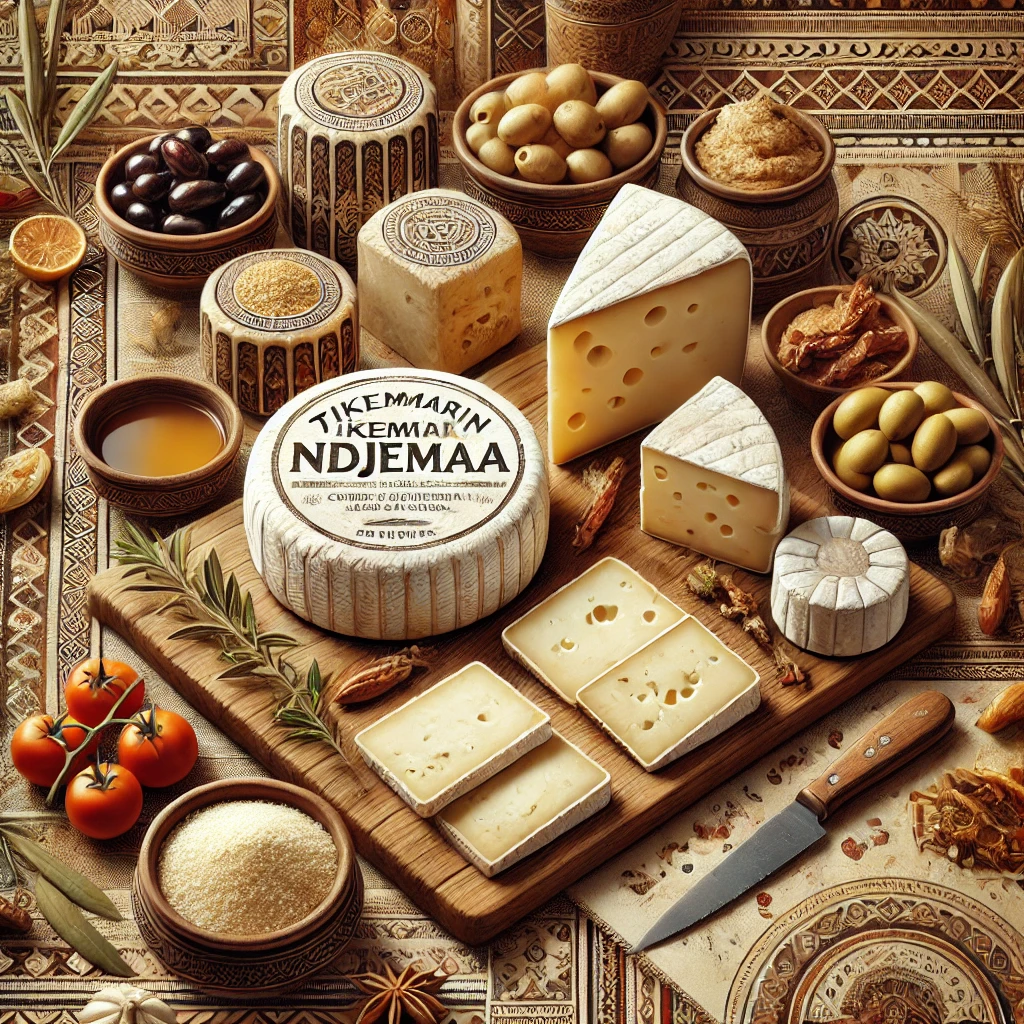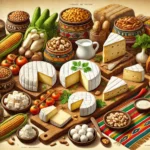Algeria’s culinary heritage is shaped by centuries of pastoralism, Berber customs, and rural craftsmanship. Among its lesser-known yet culturally meaningful foods is Tikemmarin Ndjemaa, a traditional cheese produced in certain mountainous and high-plateau regions. Passed down through generations, this artisanal cheese reflects Algeria’s deep connection to livestock, community, and natural ingredients.
Made with simple tools, pure milk, and intuitive techniques perfected over time, Tikemmarin Ndjemaa is a reminder that some of the world’s finest cheeses are not industrial products but homemade treasures. With its rustic texture, subtle tang, and versatility in traditional dishes, this cheese continues to play an important role in local diets—even as modern food trends emerge.
This guide explores the origins, production, texture, flavor, culinary uses, pairings, and cultural significance of Tikemmarin Ndjemaa, offering a deeper understanding of Algeria’s rural cheese culture.
🧀 What Is Tikemmarin Ndjemaa?
Tikemmarin Ndjemaa is a traditional Algerian cheese made primarily in villages where pastoral communities raise sheep, goats, or cattle. Because recipes vary from region to region, the cheese may appear in different shapes, textures, and salt levels, but it consistently reflects a rustic, handmade identity.
Key Characteristics
| Feature | Description |
|---|---|
| Milk | Sheep, goat, cow, or mixed |
| Type | Fresh to semi-aged artisanal cheese |
| Texture | Soft, crumbly, or lightly firm depending on aging |
| Flavor | Tangy, lactic, mildly salty |
| Color | White to pale cream |
| Usage | Everyday cooking, snacking, frying, baking |
The cheese is typically made in small batches, using freshly collected milk and traditional curdling agents, making each region’s Tikemmarin Ndjemaa slightly unique.
🌄 Origins & Cultural Significance
The name Tikemmarin or Ndjemaa is rooted in Berber and rural Algerian dialects, referring to cheeses prepared during communal gatherings or seasonal milk abundance. Traditionally, cheesemaking was essential for preserving milk before refrigeration. Over time, these techniques became cherished cultural practices.
Why Tikemmarin Ndjemaa Matters
-
connects modern households with ancestral methods
-
symbolizes rural self-sufficiency and resourcefulness
-
supports local economies and village markets
-
represents Algeria’s diverse pastoral landscapes
-
used in ceremonial meals, family gatherings, and everyday breakfasts
For many Algerian families, this cheese is not merely an ingredient—it is a symbol of heritage and continuity.
🥛 How Tikemmarin Ndjemaa Is Made
Although methods differ slightly by region, Tikemmarin Ndjemaa typically follows a traditional process using minimal equipment and natural ingredients.
1. Fresh Milk Collection
Cheesemaking begins early in the morning with fresh milk from sheep, goats, or cows—each giving the cheese a distinct character.
2. Gentle Heating
The milk is warmed slightly to encourage natural bacterial activity.
3. Coagulation
To curdle the milk, Algerian makers traditionally use:
-
natural rennet (stomach enzymes of young livestock)
-
or acidic agents like lemon juice or fermented milk
This creates a soft curd.
4. Cutting the Curds
The curd is sliced into small pieces to release whey.
5. Draining
The curds are poured into cloth sacks or perforated molds to drain slowly.
This step develops the cheese’s signature rustic texture.
6. Pressing & Shaping
Depending on the region, the curds may be:
-
hand-pressed
-
shaped into discs or balls
-
placed under stones to firm up
7. Salting
Light salting enhances flavor and helps preserve the cheese.
8. Optional Sun-Drying or Aging
Some communities dry the cheese outdoors for a firmer texture, while others consume it fresh.
The simplicity of this process is what makes Tikemmarin Ndjemaa authentically Algerian—an expression of tradition shaped by environment and necessity.
🧂 Taste & Texture Profile
The flavor of Tikemmarin Ndjemaa depends on milk source, preparation style, and age. However, the cheese consistently offers a wholesome, natural taste.
Flavor Notes
-
clean and milky
-
lightly tangy
-
subtly salty
-
earthy undertones from traditional production
Goat-milk versions tend to be sharper, while cow-milk variations are creamier and sweeter.
Texture Notes
-
fresh versions: soft, moist, slightly crumbly
-
semi-aged versions: firmer, drier, more elastic
-
sun-dried versions: dense and concentrated
This versatility allows the cheese to shine in many dishes.
🍽 Culinary Uses in Algerian Cuisine
Tikemmarin Ndjemaa appears frequently in rural Algerian cooking, especially in hearty, comforting meals.
⭐ Common Traditional Uses
1. Breakfast Cheese
Served with:
-
olive oil
-
olives
-
flatbread (khobz, kesra)
-
honey for a sweet contrast
2. Soups & Stews
Crumbled cheese enriches dishes like:
-
lentil soups
-
vegetable tagines
-
barley and wheat porridges
3. Stuffed Pastries
Used as filling for:
-
boureks
-
fried pastries
-
baked breads
4. Fried or Grilled
Like halloumi, lightly dried versions can be pan-fried until golden and crispy.
5. Side Dish with Couscous
A few crumbles add creaminess and mild tang.
⭐ Modern Uses
Creative chefs now incorporate Tikemmarin Ndjemaa into:
-
salads with herbs
-
cheese platters
-
pasta dishes
-
grilled vegetable plates
Its mild flavor adapts beautifully to fusion cuisine.
🌿 Pairings for Tikemmarin Ndjemaa
Food Pairings
| Food | Why It Works |
|---|---|
| Olives | enhances savory notes |
| Tomatoes | acidity balances dairy richness |
| Honey or date syrup | sweet contrast |
| Roasted peppers | smoky notes complement tang |
| Couscous or semolina dishes | traditional pairing |
Beverage Pairings
-
mint tea
-
herbal infusions
-
light white wines
-
ayran or leben (fermented milk drinks)
Refreshingly simple beverages work best with this rustic cheese.
🧊 Storage & Shelf Life
As a traditional fresh cheese, Tikemmarin Ndjemaa must be stored with care.
Storage Tips
-
keep refrigerated in a breathable container
-
avoid airtight plastic that traps moisture
-
lightly salt the cheese to extend freshness
-
for longer storage, sun-dry or freeze lightly
Shelf Life
| Type | Duration |
|---|---|
| Fresh | 3–5 days |
| Semi-dried | 1–2 weeks |
| Sun-dried | up to several months |
Drying is the traditional method for long-term preservation.
🌍 Comparisons with Other North African Cheeses
| Cheese | Region | Similarity | Difference |
|---|---|---|---|
| Jben | Morocco | fresh, soft | Jben is creamier and often less salty |
| Rigouta | Tunisia | made from whey | Tikemmarin is made from whole milk |
| Aghoughlou | Algeria | artisanal | Aghoughlou tends to be firmer |
| Halloumi | Cyprus | can be fried | Halloumi is saltier and denser |
Tikemmarin Ndjemaa remains unique thanks to its regional techniques and delicate flavor.
⭐ Cultural Importance
This cheese symbolizes:
-
rural unity and shared work
-
sustainability through natural food preservation
-
Algerian identity anchored in pastoral life
-
women’s craftsmanship and generational knowledge
In many communities, cheesemaking is a social act—family members gather to prepare, shape, and cook the curd together.
⭐ Conclusion
Tikemmarin Ndjemaa is a testament to Algeria’s rich culinary heritage—simple, natural, and deeply tied to community life. Its mild tang, soft texture, and versatile uses make it a cheese worth celebrating far beyond its rural origins. Whether eaten fresh with bread and olives or incorporated into hearty dishes, it offers a true taste of Algerian tradition.
As global interest in artisanal cheeses continues to grow, Tikemmarin Ndjemaa stands as a beautiful example of how local knowledge and ancestral techniques can produce foods of remarkable character and cultural value.
FAQs – Tikemmarin Ndjemaa Cheese
1. What milk is used to make Tikemmarin Ndjemaa?
Sheep, goat, cow, or a blend—depending on regional availability.
2. Is Tikemmarin Ndjemaa a fresh or aged cheese?
It can be fresh, lightly aged, or sun-dried depending on local tradition.
3. How is it eaten traditionally?
With bread, olive oil, honey, or added to soups, pastries, and stews.
4. Can this cheese be fried?
Yes—semi-dried versions fry beautifully without melting.
5. Is it commercially available?
It is mostly made in rural villages and sold in local markets, not widely exported.



